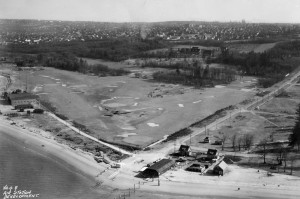Before logging and development, Jericho was a very different place. Along the shore was a salt marsh, regularly flooded by incoming tides. Three creeks fed into the marsh: one came down on what is now Discovery Street; another on the west side ran down roughly where Sasamat Street is; on the east side a third creek came into the marsh around present-day Highbury Street. Rising above the marsh on the hillside were enormous conifers, perhaps some of the largest in the region.
There may have been a Musqueam village at Jericho, but no available documentary or archaeological evidence confirms this. (The documented settlements in the area were located to the west of the park, along Locarno Beach.) Given that the marshy shoreline of Jericho was frequently inundated, it seems an unlikely choice for permanent habitation. But Jericho was rich in useful resources – salmon and trout in the streams, smelt along the beach, birds on the marshes, food plants such as crab
apple and Indian plum on drier ground. It is thought that the villages farther west at Locarno relied on food from the marsh at Jericho.
When George Vancouver arrived in English Bay in 1792, he took note of the
excellent timber on the hillsides of Point Grey, and early on, the British Navy began harvesting some of the great trees for ship's masts. In 1865, a man from New Brunswick named Jeremiah Rogers set up a logging operation in the area. It became known as Jerry’s Cove, gradually abbreviated to Jericho. By the 1870s, Rogers had moved on to South Burnaby, and Jericho became a picnicking destination for residents of Vancouver. They came to it by boat because there were no roads.
In 1890, the area was leased to the Jericho Country Club, which created the first golf course in western Canada. Developing a golf course changed the landscape significantly: a berm was built, the marshes were drained, and ornamental trees were planted. As development pushed west from Kitsilano, a new streetcar line was built to Alma Street, making it easier for the city’s residents to reach Jericho and the beaches of Spanish Banks.
Jericho tidal flats 1890, CVA AM54-S4 P41 Jericho Airbase & Golf Course 1937, CVA 371-895
In 1920, the Jericho Beach Air Station was established following Ottawa’s move to establish an air force on the west coast. A concrete airstrip was built, the remant known as ‘marginal wharf’ remained until 2011. Barracks and other buildings were constructed. Its role grew from RCAF sea boat training from 1924 to a more defensive role up to and during WWII. The current sailing centre, Youth Hostel and Arts Centre are buildings remaining from the military base.
In 1965 the federal government announced it would hand over 150 ft wide strip along the waterfront to the city and sell the rest for $12 million for housing. Luckily this didn’t happen. In 1969 a different plan was proposed and agreed to by the City of Vancouver which envisaged (1) some land turned over for parkland; (2) the top 38 acres along W 4th sold for housing and (3) Point Grey Road extended across Jericho lands to join up with Marine Drive.
In those unregenerate days public input was not looked for, so the scheme was sprung on an unsuspecting public as a fait accompli. However, the idea of citizens having a say was beginning to take hold and at a public meeting in 1971 600 angry people denounced city officials for this plan and demanded that the whole 120 acres be retained as parkland – no road and no housing.
The Jericho Park Committee was formed and started the long, frustrating job of bringing governments to listen to the will of the people. There was a 1000 ft long petition with 20,000 signatures. Finally, in 1973 the lands were sold back to the city. The Sailing Centre was established shortly thereafter Jericho was the site of the UN Habitat Forum in 1976, the last memento of which is the tree-form carving just east of the sailing club.
Jericho ponds 1977, CVA 780-440
The battle continued as to how the park itself was to be landscaped with the final plan presented in 1982. The ponds were created in what was a naturally marshy area, but some early proposals from the Park Board included a pitch & putt course, playground, even a minature railway like the one in Stanley Park. These were turned down by the community which wanted the area to remain a ‘passive’ area and left as natural as possible, which resulted in the park as you see it today. In 1989, to enhance habitat, the concrete runway was covered by a mountain of fill to create a rough meadow.+
In the following years native shrubs were planted by community groups including Nature Vancouver and there was a lot of work removing invasive plants in some areas. The Jericho Stewardship Group formed in 2004 to continue these efforts in a more organized manner.
* http://www.gassyjack.com/
+ “A Short History of Jericho Park”, Daphne Solecki, 2009


